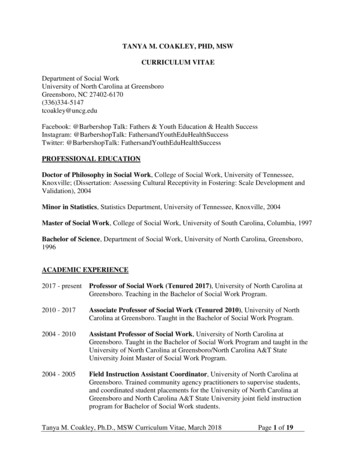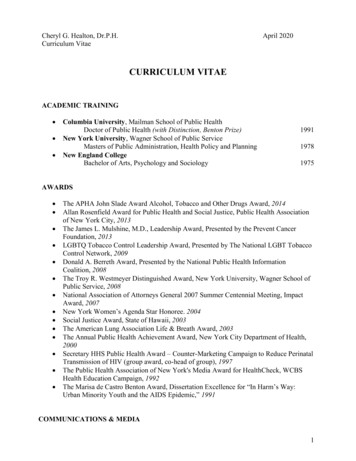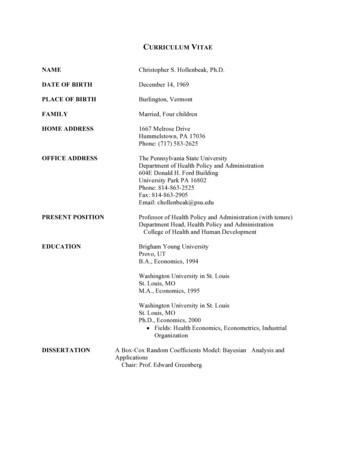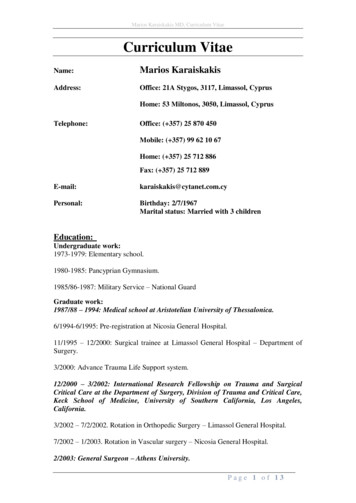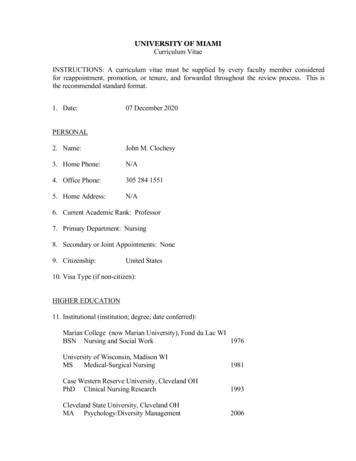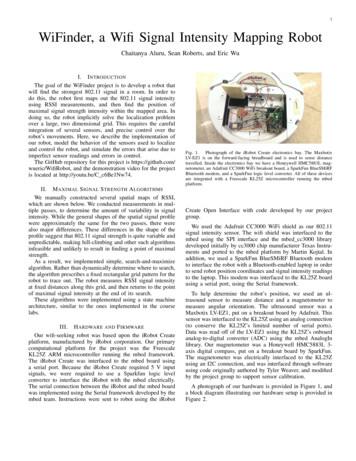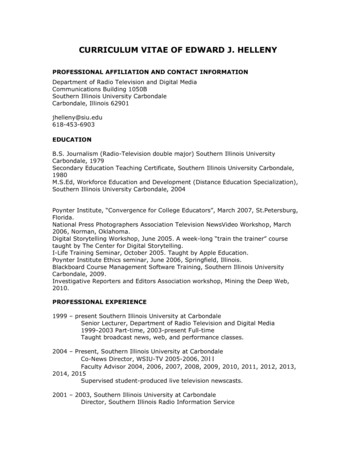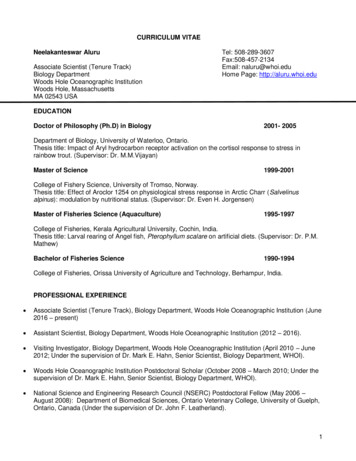
Transcription
CURRICULUM VITAENeelakanteswar AluruAssociate Scientist (Tenure Track)Biology DepartmentWoods Hole Oceanographic InstitutionWoods Hole, MassachusettsMA 02543 USATel: 508-289-3607Fax:508-457-2134Email: naluru@whoi.eduHome Page: http://aluru.whoi.eduEDUCATIONDoctor of Philosophy (Ph.D) in Biology2001- 2005Department of Biology, University of Waterloo, Ontario.Thesis title: Impact of Aryl hydrocarbon receptor activation on the cortisol response to stress inrainbow trout. (Supervisor: Dr. M.M.Vijayan)Master of Science1999-2001College of Fishery Science, University of Tromso, Norway.Thesis title: Effect of Aroclor 1254 on physiological stress response in Arctic Charr (Salvelinusalpinus): modulation by nutritional status. (Supervisor: Dr. Even H. Jorgensen)Master of Fisheries Science (Aquaculture)1995-1997College of Fisheries, Kerala Agricultural University, Cochin, India.Thesis title: Larval rearing of Angel fish, Pterophyllum scalare on artificial diets. (Supervisor: Dr. P.M.Mathew)Bachelor of Fisheries Science1990-1994College of Fisheries, Orissa University of Agriculture and Technology, Berhampur, India.PROFESSIONAL EXPERIENCE Associate Scientist (Tenure Track), Biology Department, Woods Hole Oceanographic Institution (June2016 – present) Assistant Scientist, Biology Department, Woods Hole Oceanographic Institution (2012 – 2016). Visiting Investigator, Biology Department, Woods Hole Oceanographic Institution (April 2010 – June2012; Under the supervision of Dr. Mark E. Hahn, Senior Scientist, Biology Department, WHOI). Woods Hole Oceanographic Institution Postdoctoral Scholar (October 2008 – March 2010; Under thesupervision of Dr. Mark E. Hahn, Senior Scientist, Biology Department, WHOI). National Science and Engineering Research Council (NSERC) Postdoctoral Fellow (May 2006 –August 2008): Department of Biomedical Sciences, Ontario Veterinary College, University of Guelph,Ontario, Canada (Under the supervision of Dr. John F. Leatherland).1
Visiting Postdoctoral Fellow (February 2008): Columbia River Research Laboratory, WesternFisheries Research Center, United States Geological Survey, Biological Resources Division, Cook,Washington, USA. (Under the supervision of Dr. Alec G. Maule). Postdoctoral Fellow (May 2005- April 2006): Department of Biology, University of Waterloo, Waterloo,Ontario, Canada (Under the supervision of Dr. M.M. Vijayan). Visiting postdoctoral fellow (July-August 2005): Tropical Biosphere Research Center, University of theRyukyus, Okinawa, Japan. (Under the supervision of Dr. Akihiro Takemura).AWARDS National Institute of Environmental Health Sciences (NIEHS/NIH; National Institute of Health)Outstanding New Environmental Scientist Award (February 2015) Woods Hole Oceanographic Institution Postdoctoral Scholarship (October 2008-March 2010) Natural Sciences and Engineering Research Council (NSERC) of Canada postdoctoral fellowship(May 2006-April 2008) W.B. Pearson Medal for best creative research in Biology (Ph.D., 2004). This is awarded by theFaculty of Science at University of Waterloo, Ontario, Canada. University of Waterloo graduate scholarship (2001-2004) Norwegian state educational fund scholarship (1999-2001) Indian Council of Agricultural Research (ICAR) – Senior Research Fellow (1998-1999) Indian Council of Agricultural Research (ICAR) – Junior Research Fellow (1995-1997)PROFESSIONAL AFFILIATIONS Society of Toxicology, 2009 – present DNA Methylation Society, 2015 – presentRESEARCH INTERESTS Effect of environmental stressors on epigenetic mechanisms. Role of Epigenetic mechanisms (DNA methylation and non-coding RNAs) on phenotypic plasticity.PROFESSIONAL ACTIVITIESWHOI WHOI Institutional Animal Care and Use Committee, 2012 to present. Biology Deparment Seminar Series Co-ordinator, 2012 – 2016. WHOI Coastal Ocean Institute Advisory Committee (April 2015- September 2016)Outside WHOI Ad hoc member – NIH study section review panels2
o Academic Research Enhancement Award (AREA) on topics relevant to Toxicology, Digestive,Urological and Kidney Systems (December 2018)o Neurotoxicology and Teratology section (February 2018)o Outstanding New Environmental Scientist (ONES) Award (R01) review (May 2016)o National Institute of Environmental Health Sciences Special Emphasis Panel (February 2016)o Systemic Injury to Environmental Exposure (SIEE) study section (February and October 2015)o Xenobiotic and Nutrient Disposition and Action (XNDA) study section (June 2015)o AREA grants (July 2015) Organizing committee member and toxicology session chair, 9th Aquatic models of human diseaseconference (September 29 – October 4, 2018) Co-chair, continuing education course on MicroRNAs in Biology and Toxicology at the AnnualMeeting of Society of Toxicology (2012), San Francisco, CA.PARTICIPATION IN EDUCATION PROGRAMAdvising Joint Program Studento Jordan Pitt (June 2018 – present; Co-advisor)o Alia Hidayat (June 2017 – present; Advisor)o Jennifer Panlilio (September 2013 – present; Co-advisor) Postdoctoral Scholaro Lilah Glazer, Postdoctoral Scholar (December 2013 – November 2015; Co-advisor)Summer Student FellowsoAdriane McDonald, Spelman College (Summer 2018)oVeronica De Pascuale, Oberlin College (Summer 2017)oVictoria Garefino, University of South Carolina (Summer 2016)oDaniel Chapman, Eckerd College (NOAA Hollings scholar, Summer 2016)oLily Helfrich, Northwestern University (Summer 2014)oElaine Kuo, Stanford University, California (Summer Student Fellow 2013)oKristina Deak, Northeastern University (Summer 2011)Guest studentso Ch’ng Chin Chin, Masters student, Brown Univeristy School of Public Health (April – August 2018)3
o Jan Engelhardt, Ph.D. candidate, Univeristy of Leipzig, Germany (Jan-March 2018)o Carlo Bocconcelli, Harvard University (June – August 2015)o Lukas John, Brown University (June – August 2015)o Whitney Jaillet, Rogerwilliams University (January – April 2015)o Shaneese Mackey, Savanah State University (Summer 2014)o Elizabeth Meyer, Wheaton College, Massachusetts (Winter Internship 2013) High School studentsoRebecca Butler and Anna Metri, Falmouth Academy, Massachusetts (October 2017 – January 2018)oEmma Stillman, Falmouth Academy, Massachusetts (October 2014 – January 2015)oKate Armstrong, Falmouth Academy, Massachusetts (December 2013 – January 2014)oMatthew Czarnecki, Belmont Hill High School, Massachusetts (Summer 2013)Committees and Misc. activities Joint Program Admissions Advisory Committee (Jan 2015 - Dec 2017) Presentation on Epigenetic Gene Regulation: Linking Developmental Exposure to Toxins and Toxicants toAdult Disease. Joint Program Faculty Meeting, November 13, 2014, Cambridge MA Lecture on Marine Toxicology. WHOI-BP short course, 18th September 2012, Woods Hole, Massachusetts. Lecture on Environmental Epigenetics. Summer Student Fellow Lecture Series, June 2012, Woods Hole,Massachusetts.SUPERVISION AT WHOI Technical StaffoVeronica De Pascuale, Research Assistant I (November 2018 – present)oSara Mindek, Research Assistant I (November 2017 – present)oHelena McMonagle, Research Assistant I (January 2017- January 2018)oKeegan Krick, Research Assistant I (September 2015 – August 2016; December-January 2017)oZach Mickiewicz, Research Assistant I (April 2014 – September 2016)oMat Schetne, Research Assistant I (September 2013 – December 2014)oGale Clark, Research Assistant I (June 2012 – May 2013)PAPERS IN REFEREED JOURNALS AND BOOKS(* denotes student or postdoc from my laboratory; # denotes equal contributions.)1. Glazer, L*., Kido Soule, M.C., Longnecker, K., Kujawinski, E.B., Aluru, N. 2018. Hepatic metaboliteprofiling of polychlorinated biphenyl (PCB)-resistant and sensitive populations of Atlantic killifish(Fundulus heteroclitus). Aquatic Toxicology. 205:114-122.4
2. Oh, D.-J., Hur, S.-P., Bouchekioua, S., Takeuchi, Y., Udagawa, S., Aluru, N., Park, Y-J., Park, Ji-G.,Kim, Se-J., Moon, T.W., Vijayan, M.M., Takemura, A. 2018. Tide-related changes in mRNAabundance of aromatases and estrogen receptors in the ovary and brain of the Three spot WrasseHalichoeres trimaculatus. Ocean Science Journal. 53(2), 239-249.3. Aluru, N., Karchner, S.I., Krick, K.S*., Zhu, W., Liu, J. 2018. Role of DNA methylation in altered geneexpression patterns in adult zebrafish (Danio rerio) exposed to 3, 3', 4, 4', 5-pentachlorobiphenyl(PCB 126). Environmental Epigenetics. 4(1):dvy005.4. Sadoul, B., Birceanu, O., Aluru, N., Thomas, J.K. Vijayan, M.M. 2017. Bisphenol A in eggs causesdevelopment-specific liver molecular reprogramming in two generations of rainbow trout. ScientificReports. 7(1):14131.5. Aluru, N., Karchner, S.I., Glazer, L*. 2017. Early life exposure to low levels of AHR agonist PCB126(3,3’,4,4’,5-pentachlorobiphenyl) reprograms gene expression in adult brain. Toxicological Sciences,160: 386–397.6. Aluru, N. 2017. Epigenetic effects of environmental chemicals: Insights from zebrafish. CurrentOpinion in Toxicology, 6: 26-33.7. Reid, N.M., Jackson, C.E., Gilbert, D., Minx, P., Montague, M.J., Hampton, T.H., Helfrich, L.W.*,King, B.L., Nacci, D.E., Aluru, N., Karchner, S.I., Colbourne, J.K., Hahn, M.E., Shaw, J.R., Oleksiak,M.F., Crawford, D.L., Warren, W.C., Whitehead, A. 2017. The landscape of extreme genomicvariation in the highly adaptable Atlantic killifish. Genome Biology and Evolution 9(3): 659–676.8. Faught, E., N. Aluru, M.M. Vijayan. 2016. Chapter 4. The molecular stress response. In: FishPhysiology, Volume 35. Biology of Stress in Fish. Eds. C.B. Shreck, L. Tort, A. Farrell, C. Brauner.Academic Press.9. Glazer, L*., M.E. Hahn, and N. Aluru. 2016. Delayed effects of developmental exposure to low levelsof the aryl hydrocarbon receptor agonist 3,3',4,4',5-pentachlorobiphenyl (PCB126) on adult zebrafishbehavior. Neurotoxicology, 52: 134-143.10. Lopes-Marques, M., R. Ruivo, I. Delgado, J.M. Wilson, N. Aluru, and L.F. Castro. 2015. BasalGnathostomes provide unique insights into the evolution of vitamin B12 binders. Genome Biol Evol,7(2): 457-464.11. Aluru, N., E. Kuo*, L.W. Helfrich*, S.I. Karchner, E.A. Linney, J.E. Pais, and D.G. Franks. 2015.Developmental exposure to 2,3,7,8-tetrachlorodibenzo-p-dioxin alters DNA methyltransferase (dnmt)expression in zebrafish (Danio rerio). Toxicol Appl Pharmacol, 284(2): 142-151.12. Aluru, N., S.I. Karchner, D.G. Franks, D. Nacci, D. Champlin, and M.E. Hahn. 2015. Targetedmutagenesis of aryl hydrocarbon receptor 2a and 2b genes in Atlantic killifish (Fundulus heteroclitus).Aquat Toxicol, 158: 192-201.13. Wang, L., J. Zhang, J. Duan, X. Gao, W. Zhu, X. Lu, L. Yang, J. Zhang, G. Li, W. Ci, W. Li, Q. Zhou,N. Aluru, F. Tang, C. He, X. Huang, and J. Liu. 2014. Programming and inheritance of parental DNAmethylomes in mammals. Cell, 157(4): 979-991.14. Aluru, N., M.J. Jenny, and M.E. Hahn. 2014. Knockdown of a zebrafish aryl hydrocarbon receptorrepressor (AHRRa) affects expression of genes related to photoreceptor development andhematopoiesis. Toxicol Sci, 139(2): 381-395.15. Aluru, N., K.L. Deak*, M.J. Jenny, and M.E. Hahn. 2013. Developmental exposure to valproic acidalters the expression of microRNAs involved in neurodevelopment in zebrafish. Neurotoxicol Teratol,40: 46-58.5
16. Jenny, M.J.#, N. Aluru#, and M.E. Hahn. 2012. Effects of short-term exposure to 2,3,7,8tetrachlorodibenzo-p-dioxin on microRNA expression in zebrafish embryos. Toxicol Appl Pharmacol,264(2): 262-273. [# equal contribution]17. Barkataki, S., N. Aluru, M. Li, M.M. Vijayan, and J.F. Leatherland. 2012. Characteristics of ovarianfollicle steroidogenesis during vitellogenesis in an asynchronously ovulating stock of rainbow troutOncorhynchus mykiss. J Fish Biol, 80(4): 741-751.18. Shepherd, B.S., N. Aluru, and M.M. Vijayan. 2011. Acute handling disturbance modulates plasmainsulin-like growth factor binding proteins in rainbow trout (Oncorhynchus mykiss). Domest AnimEndocrinol, 40(3): 129-138.19. Aluru, N., S.I. Karchner, and M.E. Hahn. 2011. Role of DNA methylation of AHR1 and AHR2promoters in differential sensitivity to PCBs in Atlantic Killifish, Fundulus heteroclitus. Aquat Toxicol,101(1): 288-294.20. Alsop, D. and N. Aluru. 2011. THE PITUITARY Development of the Hypothalamus-PituitaryInterrenal Axis, in Encyclopedia of Fish Physiology, A.P. Farrell, Editor., Academic Press: San Diego.p. 1450-1456.21. Vijayan, M.M., N. Aluru, Leatherland, J.F. 2010. Organismal and cellular stress, in Fish Diseasesand Disorders, Volume 2: Non-infectious Disorders, J.F. Leatherland and P.Woo. Editors., CABInternational: Oxfordshire, UK. p. 416.22. Nikaido, Y., N. Aluru, A. McGuire, Y.J. Park, M.M. Vijayan, and A. Takemura. 2010. Effect of cortisolon melatonin production by the pineal organ of tilapia, Oreochromis mossambicus. Comp BiochemPhysiol A Mol Integr Physiol, 155(1): 84-90.23. Methling, C., N. Aluru, M.M. Vijayan, and J.F. Steffensen. 2010. Effect of moderate hypoxia at threeacclimation temperatures on stress responses in Atlantic cod with different haemoglobin types. CompBiochem Physiol A Mol Integr Physiol, 156(4): 485-490.24. McGuire, A., N. Aluru, A. Takemura, R. Weil, J.M. Wilson, and M.M. Vijayan. 2010. Hyperosmoticshock adaptation by cortisol involves upregulation of branchial osmotic stress transcription factor 1gene expression in Mozambique Tilapia. Gen Comp Endocrinol, 165(2): 321-329.25. Aluru, N., J.F. Leatherland, and M.M. Vijayan. 2010. Bisphenol A in oocytes leads to growthsuppression and altered stress performance in juvenile rainbow trout. PLoS One, 5(5): e10741.26. Aluru, N. and M.M. Vijayan. 2009. Stress transcriptomics in fish: a role for genomic cortisol signaling.Gen Comp Endocrinol, 164(2-3): 142-150.27. Aluru, N. and M.M. Vijayan. 2008. Brain transcriptomics in response to beta-naphthoflavonetreatment in rainbow trout: the role of aryl hydrocarbon receptor signaling. Aquat Toxicol, 87(1): 112.28. Aluru, N. and M.M. Vijayan. 2008. Molecular characterization, tissue-specific expression, andregulation of melanocortin 2 receptor in rainbow trout. Endocrinology, 149(9): 4577-4588.29. Park, C.B., A. Takemura, N. Aluru, Y.J. Park, B.H. Kim, C.H. Lee, Y.D. Lee, T.W. Moon, and M.M.Vijayan. 2007. Tissue-specific suppression of estrogen, androgen and glucocorticoid receptor geneexpression in feral vitellogenic male Mozambique tilapia. Chemosphere, 69(1): 32-40.30. Moran, P.W., N. Aluru, R.W. Black, and M.M. Vijayan. 2007. Tissue contaminants and associatedtranscriptional response in trout liver from high elevation lakes of Washington. Environ Sci Technol,41(18): 6591-6597.31. Aluru, N. and M.M. Vijayan. 2007. Hepatic transcriptome response to glucocorticoid receptoractivation in rainbow trout. Physiol Genomics, 31(3): 483-491.6
32. Vijayan, M.M., N. Aluru, A.G. Maule, and E.H. Jorgensen. 2006. Fasting augments PCB impact onliver metabolism in anadromous arctic char. Toxicol Sci, 91(2): 431-439.33. Jorgensen, E.H., M.M. Vijayan, J.E. Killie, N. Aluru, Ø. Aas-Hansen, and A. Maule. 2006.Toxicokinetics and effects of PCBs in Arctic fish: a review of studies on Arctic charr. J ToxicolEnviron Health A, 69(1-2): 37-52.34. Aluru, N. and M.M. Vijayan. 2006. Aryl hydrocarbon receptor activation impairs cortisol response tostress in rainbow trout by disrupting the rate-limiting steps in steroidogenesis. Endocrinology, 147(4):1895-1903.35. Aluru, N. and M.M. Vijayan. 2006. Resveratrol affects CYP1A expression in rainbow trouthepatocytes. Aquat Toxicol, 77(3): 291-297.36. Cara, J.B., N. Aluru, F.J. Moyano, and M.M. Vijayan. 2005. Food-deprivation induces HSP70 andHSP90 protein expression in larval gilthead sea bream and rainbow trout. Comp Biochem Physiol BBiochem Mol Biol, 142(4): 426-431.37. Aluru, N., K. Vuori, and M.M. Vijayan. 2005. Modulation of Ah receptor and CYP1A1 expression byalpha-naphthoflavone in rainbow trout hepatocytes. Comp Biochem Physiol C Toxicol Pharmacol,141(1): 40-49.38. Aluru, N., R. Renaud, J.F. Leatherland, and M.M. Vijayan. 2005. Ah Receptor-mediated impairmentof interrenal steroidogenesis involves StAR protein and P450scc gene attenuation in rainbow trout.Toxicol Sci, 84(2): 260-269.39. Aluru, N. and M.M. Vijayan. 2004. beta-Naphthoflavone disrupts cortisol production and liverglucocorticoid responsiveness in rainbow trout. Aquat Toxicol, 67(3): 273-285.40. Aluru, N., E.H. Jorgensen, A.G. Maule, and M.M. Vijayan. 2004. PCB disruption of thehypothalamus-pituitary-interrenal axis involves brain glucocorticoid receptor downregulation inanadromous Arctic charr. Am J Physiol Regul Integr Comp Physiol, 287(4): R787-793.41. Jorgensen, E.H., M.M. Vijayan, N. Aluru, and A.G. Maule. 2002. Fasting modifies Aroclor 1254impact on plasma cortisol, glucose and lactate responses to a handling disturbance in Arctic charr.Comp Biochem Physiol C Toxicol Pharmacol, 132(2): 235-245.PUBLISHED ABSTRACTS1. Hahn, M.E., Karchner, S.I., Becker, C.C., Aluru, N. Franks, D.G., Goldstone, J.V., Stegeman, J.J.,Champlin, D., Nacci, D., Clark, B.W., Jayaraman, S., Kartha, V., Monti, S. 2018. Developmentaleffects of Ortho-substituted PCB-153: Evidence for altered glucose homeostasis in PCB-sensitivekillifish and in zebrafish, but not in PCB-tolerant killifish from a Superfund site. The Toxicologist,Supplement to Toxicological Sciences, 150 (1), Abstract #2010.2. Aluru, N., Chapman, D., McMonagle, H., Becker, B., Van Mooy, B., Karchner, S.I., Stegeman, J.J.,Hahn, M.E. 2018. Developmental exposure to low-level saxitoxin affects neuronal gene expression.The Toxicologist, Supplement to Toxicological Sciences, 150 (1), Abstract #1415.3. Karchner, S.I., Jenny, M.J., Aluru, N., Franks, D.G., Laub, L.B., Linney, E., Williams, L.M., Teraoka,H., Hahn, M.E. 2017. Evidence for developmental versus toxicological roles for zebrafish AHR1b.The Toxicologist, Supplement to Toxicological Sciences, 150 (1), Abstract #1165.4. Krick, K., Karchner, S.I., Stegeman, J.J., Hahn, M.E., Aluru, N. 2017. Developmental Exposure toPCB153 Alters Genes Related to Circadian Rhythm and Metabolism in Zebrafish (Danio rerio). TheToxicologist, Supplement to Toxicological Sciences, 150 (1), Abstract #1213.7
5. Aluru, N., Glazer, L., Hahn, M.E. 2017. Early life exposure to low levels of AHR agonist PCB126(3,3’,4,4’,5-pentachlorobiphenyl) reprograms gene expression in adult brain. The Toxicologist,Supplement to Toxicological Sciences, 150 (1), Abstract #2219.6. Panlilio, J.M., Aluru, N., Hahn, M.E. 2017. Domoic Acid Exposure during a Critical Period inDevelopment Causes Myelination Deficits and Alters the Startle Response. The Toxicologist,Supplement to Toxicological Sciences, 150 (1), Abstract #2614.7. Birceanu, O., Dindia, L., Mohammad, A., Woody, O., McConkey, B., Aluru, N., Vijayan, M.M. 2016. Fromtranscriptome to metabolome: Multigenerational biomarkers of BPA exposure during embryogenesis. In:Laurentian SETAC 21st Annual General Meeting and Conference. June 24, 2016. University of Waterloo,Waterloo, Ontario, Canada.8. Aluru, N., Karchner, S.I., Krick, K. Role of DNA Methylation in Altered Gene Expression Patterns in AdultZebrafish (Danio rerio) Exposed to 3,3',4,4',5‐Pentachlorobiphenyl (PCB 126). In: 2016 Annual MeetingAbstract Supplement, Society of Toxicology, 2016. Abstract no. 3837.9. Hahn, M.E., Aluru, N., Karchner, S.I., Franks, D.G. Altered Basal and TCDD-induced Gene Expression inAHRRa-Null Zebrafish Embryos Generated by ZFN-Mediated Gene Targeting. In: The Toxicologist:Supplement to Toxicological Sciences, 150(1), Society of Toxicology, 2016. Abstract no. 2424.10. Panlilio, J.M., N. Aluru, and M.E. Hahn. 2015. Domoic acid targets developing oligodendrocytes topotentially mediate toxicity in the nervous system. Neurotoxicology and Teratology, 49: 130-131.11. Glazer, L., N. Aluru, and M.E. Hahn. 2015. Delayed neurobehavioral effects caused by zebrafish embryonicexposure to low levels of PCB-126. Neurotoxicology and Teratology, 49: 129.12. Glazer, L., Aluru, N., Hahn, M.E. When zebrafish ‘misbehave’- learning about delayed effects of low levelembryonic contaminant exposure from adult zebrafish behavior. In: The Toxicologist: Supplement toToxicological Sciences, 144(1), Society of Toxicology, 2015. Abstract no. 267.13. Glazer, L., Soule, M., Longnecker, K., Kujawinski, E.B., Aluru, N. Hepatic metabolite profiling of Atlantickillifish (Fundulus heteroclitus) from PCB-resistant and sensitive populations. In: 2015 Annual MeetingAbstract Supplement, Society of Toxicology, 2015. Abstract no. 2497.14. Kuo, E., Karchner, S.I., Yu, Z., Aluru, N. Effect of 2,3,7,8-tetrachlorodibenzo-p-dioxin (TCDD) exposure onthe expression of DNMT genes during development in zebrafish (Danio rerio). In: The Toxicologist:Supplement to Toxicological Sciences, 138(1), Society of Toxicology, 2014. Abstract no. 965.15. Aluru, N., Karchner, S.I., Jenny, M.J., Hahn, M.E. Understanding the physiological role of Aryl HydrocarbonReceptor Repressor (AhRR) using gene knock-down and targeted mutagenesis in zebrafish. In: TheToxicologist: Supplement to Toxicological Sciences, 132(1), Society of Toxicology, 2013. Abstract no. 1288.16. Aluru,N., Deak, K.L., Jenny, M.J. Hahn, M.E. MicroRNA expression profiling after developmental exposureof zebrafish embryos to valproic acid. In: The Toxicologist: Supplement to Toxicological Sciences, 126(1),Society of Toxicology, 2012. Abstract no. 1936.17. Aluru, N., Marsit, C.J. MicroRNAs in Biology and Toxicology. Overview of MicroRNA QuantificationMethods. In: The Toxicologist: Supplement to Toxicological Sciences, 126(1), Society of Toxicology, 2012.Abstract no. 10. (Platform presentation)18. Aluru, N., Jenny, M.J., Hahn, M.E. MicroRNA expression profiles after developmental exposure of zebrafish(Danio rerio) embryos to TCDD. In: The Toxicologist: Supplement to Toxicological Sciences, 120(2), Societyof Toxicology, 2011. Abstract no. 1642.19. Hahn, M.E., Karchner, S.K., Jenny, M.J., Franks, D.G., Reitzel, A.M., Timme-Laragy, A.R., Aluru, N., Nacci,D.E., Oleksiak, M.F. Gene-Environment Interactions and Dioxin Sensitivity in Natural and LaboratoryPopulations of Fish. In: The Toxicologist: Supplement to Toxicological Sciences, 120(2), Society ofToxicology, 2011. Abstract no. 1776.8
20. Aluru, N., Leatherland, J.F., Vijayan, M.M. Developmental and growth effects associated with acuteexposure of eggs to bisphenol A in rainbow trout. In: The Toxicologist: Supplement to ToxicologicalSciences, 108(1), Society of Toxicology, 2009. Abstract no. 1302. (Platform presentation)21. Moran, P.W., Black, B., Aluru, N., Vijayan, M.M. 2008. Liver Transcriptomics in trout collected across agradient of urbanization in Puget Sound, Washington State, USA. 26th Annual Meeting of Society ofEnvironmental toxicology and chemistry (SETAC), 16-20 November, Tampa, Florida, USA.22. Aluru, N., Moran, P.W., Vijayan, M.M. 2005. Patterns of gene expression using cDNA microarray in troutcollected from high alpine lakes in Washington state. 26th Annual Meeting of SETAC North America.November 13-17, Baltimore, Maryland, USA.23. Vijayan, M.M. and Aluru, N. 2005. Ah receptor activation impairs the rate limiting steps in steroidogenesis inrainbow trout. 26th Annual Meeting of SETAC North America. November 13-17, Baltimore, Maryland, USA.INVITED LECTURES AND PAPERS PRESENTED AT MEETINGSInvited Lectures1. Aluru, N. 2018. Epigenetic effects of environmental exposures. 13th International congress on thebiology of fish, Calgary, Alberta, Canada (July 15-19, 2018).2. Aluru, N. 2018. Role of epigenetics in environmental adaptation to stressors: Implications to Oceanacidification research. Ocean Acidification Research Kick off meeting, Norwegian Institute of MarineResearch, Tromsø, Norway (June 28, 2018).3. Aluru, N. 2018. Ecological Epigenetics: Implications for Adaptation to Changing MarineEnvironments. Ocean Outlook meeting. WHOI (May 2-4, 2018).4. Aluru, N. 2018. My Grant Funding story. Research Funding Insights Session: Research Funding 101:Multiple Perspectives on the NIH Grant Process. 57th Annual Meeting of Society of Toxicology, SanAntonio, Texas (March 11-15, 2018).5. Aluru, N. 2018. Environmental exposures, sensitive windows of development and epigeneticregulation. Gijs van Seventer Seminar Series, Boston University School of Public Health. February 16,2018.6. Aluru, N. 2017. Environmental chemical exposures, epigenetic effects and gene expression changes.Connecticut Valley Zebrafish Meeting, Brown University. November 3, 2017.7. Aluru, N., Jenny Panlilio, Lilah Glazer, Sibel Karchner, John Stegeman, Mark Hahn. Oceans and HumanHealth: Effects of developmental exposure to marine toxins and toxicants. 8th Aquatic Animal Models ofHuman Disease Conference, Birmingham, AL, January 2017.8. Aluru, N. 2016. Submitting trainee and career initiation grants. Northeast Superfund Research Programtraining workshop (April 26-27, 2016).9. Aluru, N. 2015. Role of epigenetics in environmental toxicology. Presented at Department of Arctic Biology,May 22nd, University of Tromso, Norway.10. Aluru, N. 2014. Role of epigenetics in developmental basis of adult health and disease. Presented at LuducBioimaging facility, November 7th, Department of Molecular Biology, Cell Biology and Biochemistry, BrownUniversity.9
11. Aluru, N. 2014. Understanding the Mechanisms Associated with Developmental Exposure to Marine Toxinsand Toxicants. Gordon Research Conference on Oceans and Human Health. June 1-6, University of NewEngland, Maine.12. Aluru, N. 2010. Endocrine Physiology of stress response: Long term effects of short-term exposures. ArnoldSchool of Public Health, University of South Carolina. October 24 th 2010, Columbia, South Carolina.13. Aluru, N. 2007. Endocrine and developmental toxicity in fish: Mechanisms and Implications. Invited speakerat Department of Integrative Biology Fish and Loaves Seminar Series. 19 th October, University of Guelph,Guelph, Ontario, Canada.Oral Presentations1. Hahn, M.E., Karchner, S.I., Aluru, N., Franks, D.G., Goldstone, J.V., Stegeman, J.J., Champlin, D., Clark, B.,Jayaraman, S., Nacci, D., Kartha, V., Reed, E., Monti, S. Molecular Ecology at Superfund Sites: Applicationof population genomics and genome editing to understand genetic mechanisms of adaptation following multigenerational exposure to chemical mixtures. National Institute of Environmental Health Sciences (NIEHS)Superfund Research Program 30th Annual Meeting, Philadelphia, PA. (December 6-8, 2017).2. Hahn, M.E., Aluru, N., Karchner, S.I. Applications of Genome Editing to Understand Molecular Mechanismsof Chemical Sensitivity and Resistance. The promise of genome editing tools to advance environmentalhealth research, National Academies of Sciences, Engineering, and Medicine, Washington, D.C. (January10-11, 2018).3. Panlilio, J.M., Aluru, N., Hahn, M.E. 2017. Exposure to domoic acid during a critical period ofneurodevelopment alters myelin sheath formation and leads to behavioral deficits. Talk by Jennifer Panlilio atthe Joint Meeting of the Neurotoxicity Society and the International Neurotoxicology Association, May 2017,Florianopolis, Brazil.4. Panlilio, J.M., Aluru, N., Hahn, M.E. 2017. Novel mechanisms of neurotoxicity from developmental exposuresto domoic acid. Talk by Jennifer Panlilio at Gordon Research Conference in Phycotoxins and Mycotoxins,July 2017.5. Aluru, N. 2017. Oceans and human health: Understanding how environment influences our genes WHOISummer Student Fellow Lecture. July 5, 2017, Redfield Auditorium.6. Aluru, N. 2016. The role of epigenetics in organismal responses to environmental change. WHOI SummerStudent Fellow Lecture. July 6, 2016, Redfield Auditorium.7. Aluru, N. 2016. Role of DNA methyltransferases in toxicant-induced alterations in DNA methylation. ONESAwardee symposium. NIEHS Building 101, Rodbell Auditorium. May 17-18, 2016, Research Triangle Park,North Carolina.8. Birceanu, O., Mohammad, A., Woody, O., McConkey, B., Aluru, N., Vijayan, M.M. 2016. Multigenerationaleffects of Bisphenol A on the rainbow trout transcriptome. 55th Annual Meeting of Canadian Society ofZoologists. May 9-13, 2016. Western University, London, Ontario, Canada.9. Aluru, N. 2016. Hidden layers of the genome: The role of epigenetics in organismal responses toenvironmental change. Biology Department seminar, April 28th, 2016, Woods Hole Oceanographic institution.10. Aluru, N. 2016. Behavioral and Epigenetic Effects of PCB Exposure. Oceans and Human Health GranteeMeeting, April 13-14, 2016, NIEHS, Research Triangle Park, NC.11. Aluru. N. 2016. Oceans and Human Health: Long-term consequences to toxicant exposure. Central MarineFisheries Research Institute, 30th January 2016, Cochin, Kerala, India.10
12. Aluru, N., Ingeborg, H., Helgason, L.B., Harju, M. 2015. Transcriptomic changes associated with exposure toorganophosphorus flame retardants in Atlantic cod (Gadus morhua). 18th International symposium onPollutant Responses in Marine Organisms (PRIMO18), May 24-27, 2015, Trondheim, Norway.13. Aluru, N., Karchner, S.I., Franks, D.G., Nacci, D., Champlin, D., Hahn, M.E. 2014. Understanding themolecular basis of evolved resistance to PCBs in fish and its impacts on sensitivity to multiple stressors.Eighth International PCB Workshop, October 5-9, Marine Biological Laboratory, Woods Hole, MA.14. Aluru, N., Jenny, M.J., Hahn, M.E. 2010. MicroRNA expression profiles after developmental exposure ofzebrafish (Danio rerio) embryos to TCDD. NUTMEG Conference. October 7-9, Woods Hole, Massachusetts,USA.15. Aluru, N. 2009. Endocrine Physiology of stress response: Integrated effects of nutrition and persistentorganic pollutants. Biology Seminar Series, 24th September, Biology Department, Woods HoleOceanographic Institution, Woods Hole, Massachusetts, USA.16. Aluru, N., Leatherland, J.F., Vijayan, M.M. 2008. Bisphenol A impacts embryogenesis and growth bydisrupting the GH-IGF axis in rainbow trout. NUTMEG Conference. October 6-7, Woods Hole,Massachusetts, USA.17. Vijayan, M.M., Aluru, N. 2008. Melanocortin 2 receptor and its role in the stress response. 8th InternationalCongress
College of Fisheries, Kerala Agricultural University, Cochin, India. Thesis title: Larval rearing of Angel fish, Pterophyllum scalare on artificial diets. (Supervisor: Dr. P.M. Mathew) Bachelor of Fisheries Science 1990-1994 College of Fisheries, Orissa University of Agriculture and Technology, Berhampur, India. PROFESSIONAL EXPERIENCE
